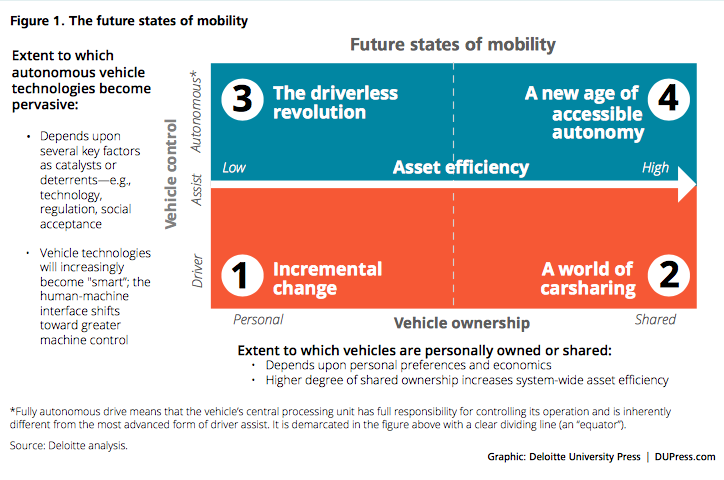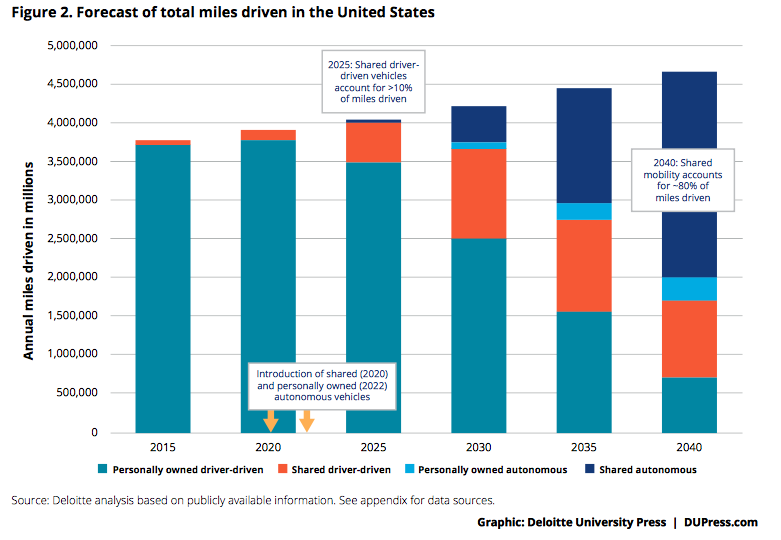Tomorrows mobility system – and how to succeed in it
Part of a deloitte series on the future of mobility
Frictionless, automated, personalized travel on demand—that’s the dream of the future of mobility. And the future mobility ecosystem’s various elements are coalescing to realize that dream sooner than expected, which means that incumbents and disruptors need to move at top speed to get on board.
Many questions remain, given the dynamic and changing environment of this topic:
• How quickly will the future arrive, and how sweeping will the changes be?
- What will the new ecosystem look like, and how will it operate?
- Where will value be created and captured?
- How should an organization transform its strat- egy, business model, product portfolio, and ca- pabilities to succeed?
This paper, from Deloitte, aims to advance the collective thinking around answering these questions. It extends the initial perspectives and incorporates new insights and analyses gained from an extensive and ongoing dialogue with most of the key players driving these changes. Ultimately, this article will, hopefully, provides a roadmap of sorts, helping stakeholders determine where to play and how to win.
4 concurrent “future states” within the ecosystem of mobility
The following four situations emanate from the intersection of who owns the vehicle and who operates it:
- Incremental change: This vision of the future sees private ownership remaining the norm as consumers opt for the forms of privacy, exibility, security, and convenience that come with owning a vehicle. While incorporating driver-assist technologies, this future state assumes that fully autonomous drive doesn’t completely displace driver-controlled vehicles anytime soon.
- A world of carsharing: The second future state anticipates continued growth of shared access to vehicles through ridesharing and carsharing. Economic scale and increased competition drive the expansion of shared vehicle services into new geographic territories and more specialized customer segments. As shared mobility serves a greater proportion of local transportation needs, multivehicle households can begin reducing the number of cars they own, while others may eventually abandon ownership altogether.
- The driverless revolution: The third state is one in which autonomous drive technology* proves viable, safe, convenient, and economical, yet private ownership continues to prevail. Drivers still prefer owning
their own vehicles but seek driverless functionality for its safety and convenience. This future will see a proliferation of highly customized, personalized vehicles catering to families or individuals with speci c needs. - A new age of autonomy: The fourth future state anticipates a convergence of both the autonomous and vehicle sharing trends. Mobility management companies and eet operators o er a range of passenger experiences to meet widely varied needs at di erentiated price points. Taking o rst in urban areas but spreading to the suburbs, this future state provides seamless mobility.
This paper suggests that these changes could occur more quickly and at a greater scale than many are prepared for. The modeling finds that the changes will begin within 5 years and that the market for mobility could change dramatically over 25 years. This leads to the following forecasts:
New opportunities to create value: placing bets on the future of mobility
As customer’s needs are idiosyncratic, new opportunities will emerge that will deliver diverse experiences that they demand. Companies will look to design new products, services, and beginning to stake out solutions that serve each future state and multiple modes of travel simultaneously or accept a narrowing of their future horizons in a more diverse mobility ecosystem. Therefore, the roles of companies, but also customer experiences will be subject to changes:
- Vehicle development: the carmaking business will be more complex than ever. New products will likely emerge, from small utilitarian autonomous “pods” to highly customized, personally owned self- driving cars.
- The in vehicle-transit-experience: As shared and autonomous mobility proliferate, a tremendous opportunity arises for companies seeking to sell content, entertain, and generally enhance the time spent in-transit. This will likely split into two kind of services:
- In vehicle services: From meals to shopping, and beyond.
- Predictive content analysis: maximizing the in-vehicle experience by providing content seamlessly and to intuitively assist passengers with where they are going.
- Content creation: new possibilities that will emerge to develop immersive and interactive videos, music, and games.
- Infrastructure enablers: The safe and efficient movement of people and goods.
- Mobility management: a seamless intermodal transportation experience, ensuring easy access, exemplary in-transit experience, a smooth payment process, and overall customer satisfaction.
This article was written, just to summarize the foreseeable change to autonomous driving. Read the full article from Deloitte. here
Source: University Press Deloitte


